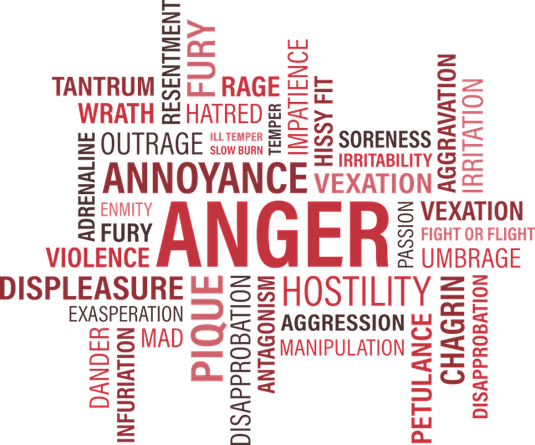cbt for anger management
WHAT IS ANGER?

Everyone gets angry. Anger is a natural response to threats; it can inspire us to defend ourselves when attacked or motivate us to deal with injustice or problem situations.
However, we all need to manage our anger. Social norms and common sense tells us that we can’t lash out every time someone irritates or upsets us.
Anger varies in intensity: what makes one person mildly irritated might trigger intense rage in another. Similarly, people express anger in different ways. Some do so verbally: they may shout, swear, name-call or make threats. Others become violent, hitting or pushing others or breaking things. Some people display anger in more passive ways – for example, ignoring others or sulking. Other people may feel very angry but keep it all bottled up or turn it against themselves – for example, they might cope with their intense emotions by self-harming.
Anger and aggression are not the same thing. Anger is an emotion that we feel, while aggression is the behaviour that sometimes stems from angry thoughts and feelings. You can be angry but choose not to behave aggressively.
ANGRY THOUGHTS, PHYSICAL SYMPTOMS AND BEHAVIOURS

Anger tends to be associated with hostile thoughts, physiological arousal and maladaptive behaviours.
Thoughts often focus on perceived rights and wrongs and a sense of injustice (‘I’m being disrespected’; ‘I’m being treated badly/unfairly’, ‘I’ve been let down again’, ‘They’re making a fool of me’). There is often a sense others have fallen short of our standards or expectations (‘This isn’t good enough’; ‘I won’t stand for it’, ‘I can’t trust anyone’).
Anger results in physiological changes. Your heart rate and blood pressure go up and your adrenaline levels rise. It can impair concentration and memory. Other physical symptoms can include fist or teeth clenching, tense muscles, stomach churning/butterflies, and shaking, amongst others.
When angry, you may feel restless, tense, on edge, uptight. You may feel the urge to hit out; shout or argue; ignore or not talk to a person/sulk; storm away from a situation; or make sarcastic comments.
CAUSES OF ANGER

- Learnt behaviour and family background: People who are easily angered may come from a difficult or chaotic family background. They may have never learnt or been encouraged to express their feelings healthily. Emotional deprivation (for example, not receiving empathy or nurture when young) and punitive parenting (being criticised or shamed frequently; feeling invalidated) can create mistrust, low self-esteem and anger.
- A negative thinking style: Difficult events or situations can result in a negative thinking style. This can become ingrained over time and part of one’s outlook on life. Negative thinking can become a bad habit, so much so you might not be aware that your thinking has become excessively negative and how it is impacting on your days. Unsurprisingly, a persistently negative outlook can cause anger problems.
- A low tolerance for frustration: While some people laugh off or forget about minor everyday frustrations (traffic jams, a poor phone or internet connection, unfriendly shopkeepers, etc), others find it difficult to let go and may still be fuming hours later. People who are easily angered tend to have what’s known as a low tolerance for frustration. One’s genes and one’s upbringing/environment can influence whether you have a low tolerance for frustration. Frustrations are unavoidable in life, so building up your tolerance is an essential part of anger management.
- Stress: Stressful life events – being bullied or abused, divorce or separation, financial pressures, losing one’s job – can drive anger.
- Your environment: You may feel weighed down by work or home pressures. You may feel everything is left to you, that you are taken for granted, that you have no time for yourself, that you have fallen into an unstimulating ‘trap’.
EFFECTS AND CONSEQUENCES OF ANGER
- Some people think it’s good to ‘let it all out’, that doing so gets the anger out of your system. In fact, research shows doing so results in an escalation in anger and aggression levels.
- Anger hurts relationships, whether they be romantic, familial, friendships or professional. ‘You’re always messing up!’, ‘This damn machine never works’, ‘Everyone is against me’ – these kind of black-and-white statements upset and alienate the person hearing them, and make them less inclined to help you.
- Anger distorts thinking patterns. Instead of trying to calmly resolve problems, anger exaggerates them. This can briefly fortify your self-esteem by making you feel your anger is justified, but it ultimately fosters feelings of hopelessness, making surmountable problems seem insurmountable.
- People often feel very badly about themselves after an angry outburst, leading to feelings of guilt and shame.
- Unexpressed anger brings its own problems. People who keep their frustrations to themselves will often act in a passive-aggressive manner. They may undermine others indirectly, without ever telling them why they are upset. They may become cynical and hostile, constantly criticising others and emphasising the negative. This only compounds their social isolation, further driving their underlying anger. Others turn their anger in on themselves and release their tensions by self-harming.
CBT FOR ANGER MANAGEMENT
